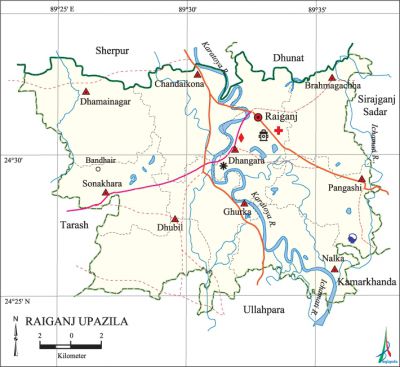Raiganj Upazila
Raiganj Upazila (sirajganj district) area 259.74 sq km, located in between 24°25' and 24°34' north latitudes and in between 89°24' and 89°37' east longitudes. It is bounded by sherpur (bogra) and dhunat upazilas on the north, ullahpara and kamarkhanda upazilas on the south, sirajganj sadar and Kamarkhanda upazilas on the east, tarash upazila on the west.
Population Total 317666; male 158604, female 159062; Muslim 282558, Hindu 34819, Christian 38 and others 251.
Water bodies Main rivers: karatoya, ichamati.
Administration Raiganj Thana was formed in 1937 and it was turned into an upazila in 1984.
| Upazila | ||||||||
| Municipality | Union | Mouza | Village | Population | Density (per sq km) | Literacy rate (%) | ||
| Urban | Rural | Urban | Rural | |||||
| 1 | 9 | 191 | 267 | 18890 | 298776 | 1223 | 54.8 (2001) | 36.7 |
| Municipality | ||||||||
| Area (sq km) |
Ward | Mahalla | Population | Density (per sq km) |
Literacy rate (%) | |||
| - | 9 | 29 | 17318 | - | 61.3 | |||
| Upazila Town | ||||||||
|
Area (sq km) |
Mouza |
Population |
Density (per sq km) |
Literacy rate %) | ||||
| 2.62 | 2 | 6762 | 2581 | 54.75 | ||||
| Union | ||||
| Name of union and GO code | Area (acre) | Population | Literacy rate (%) | |
| Male | Female | |||
| Ghurka 57 | 6467 | 19046 | 18478 | 42.7 |
| Chandaikona 19 | 7906 | 20643 | 20643 | 41.9 |
| Dhangara 38 | 5361 | 14471 | 14494 | 36.6 |
| Dhamainagar 28 | 8548 | 9988 | 10523 | 35.3 |
| Dhubil 47 | 6625 | 14232 | 14211 | 35.4 |
| Nalka 66 | 7675 | 19948 | 19979 | 37.2 |
| Pangashi 76 | 6574 | 19607 | 19874 | 30.2 |
| Brahmagachha 13 | 6896 | 20027 | 19902 | 31.3 |
| Sonakhara 85 | 6393 | 11987 | 12295 | 40.4 |
Source Bangladesh Population Census 2001 and 2011, Bangladesh Bureau of Statistics.

Archaeological heritage and relics Dhangara Mosque (Dhangara union), Khariza Ghughat Mosque (Dhubil union), Birat Rajar Bari at Nimgachhi.
War of Liberation In 1971 the Pak army conducted mass killing and plundering at Salanga, Pangashi, Dhangara and Chandaikona Bazar of the upazila; they also set many houses on fire. Raiganj was under sector of the War of Liberation. Freedom fighters had encounters with the Pak army at three places of the upazila and these were Brahmagachha, Raiganj Police Station and Raiganj CO office. Freedom fighters had attacked the Pakistan army on their retreat to Dhaka after the loss of hold at Bogra and the enemies were disarrayed. This upazila was liberated on 12 December.
For details: see রায়গঞ্জ উপজেলা, বাংলাদেশ মুক্তিযুদ্ধ জ্ঞানকোষ (Encyclopedia of Bangladesh War of Liberation), বাংলাদেশ এশিয়াটিক সোসাইটি, ঢাকা ২০২০, খণ্ড ৯।
Religious institutions Mosque 361, temple 55, tomb 2. Noted religious institutions: Dhangara Mosque, Khariza Ghughat Mosque, Bhola Dewan (R) Tomb, Rajar Bari Mandir.
Literacy rate and educational institutions Average literacy 38.1%; male 41.1%, female 35.2%. Educational institutions: college 11, secondary school 43, madrasa 37. Noted educational institutions: Salanga Degree College (1970), Hazi Wahed Mariam Degree College (1972), Dhangara Mohila College (1999), Salanga Mohila College (1999), Chandaikona Multilateral High School (1921), Dhangara High School (1950), JKA Mannan High School (1973), Dhangara Fazil Madrasa (1976).
Cultural organisations Library 2, cultural organisation 2, women organisation 3, playground 6.
Main sources of income Agriculture 69.27%, non-agricultural labourer 2.93%, industry 4.46%, commerce 11.25%, transport and communication 2.51%, service 3.90%, construction 0.90%, religious service 0.17%, rent and remittance 0.18% and others 5.33%.
Ownership of agricultural land Landowner 55.99%, landless 44.01%; agricultural landowner: urban 35.59% and rural 56.49%.
Main crops Paddy, jute, potato, sugarcane, wheat, pulse, vegetables.
Main fruits Mango, jackfruit, litchi, banana, papaya, guava, blackberry.
Fisheries, dairies and poultries Fishery 38, dairy 8, poultry 28, hatchery 5.
Communication facilities Pucca road 128 km, mud road 643 km. Bridge 24, culvert 257.
Extinct or nearly extinct traditional transport Palanquin, dhuli, horse carriage.
Noted manufactories Rice mill, flour mill, ice factory, saw mill, welding factory.
Cottage industries Blacksmith, potteries, weaving, embroidery, bamboo work, cane work.
Hats, bazars and fairs Hats and bazars are 9, fairs 5, most noted of which are Chandaikona Hat, Salanga Hat, Dhamai Hat, Amshara Hat, Brahmagachha Hat, Nalka Hat, Rudrupur Hat, Krishnadia Hat, Nimgachhi Mela and Dhangara Mela.
Access to electricity All the unions of the upazila are under rural electrification net-work. However 33.6% of the dwelling households have access to electricity.
Sources of drinking water Tube-well 95.4%, tap 0.7% and others 3.9%. The presence of arsenic has been detected in 23.32% of the shallow tube-well water of the upazila.
Sanitation 61.8% of dwelling households of the upazila use sanitary latrines and 28.8% of dwelling households use non-sanitary latrines; 9.4% of households do not have latrine facilities.
Health centres Upazila health complex 1, health centre 9.
Natural disasters Many people were victims of the famines of 1897, 1943 and 1974. Besides, the earthquakes of 1885 and 1897 caused heavy damages to settlements and other properties of the upazila.
NGO activities Operationally important NGOs are brac, proshika. [Monayem Khan]
References Bangladesh Population Census 2001 and 2011, Bangladesh Bureau of Statistics; Cultural survey report of Raiganj Upazila 2007.
